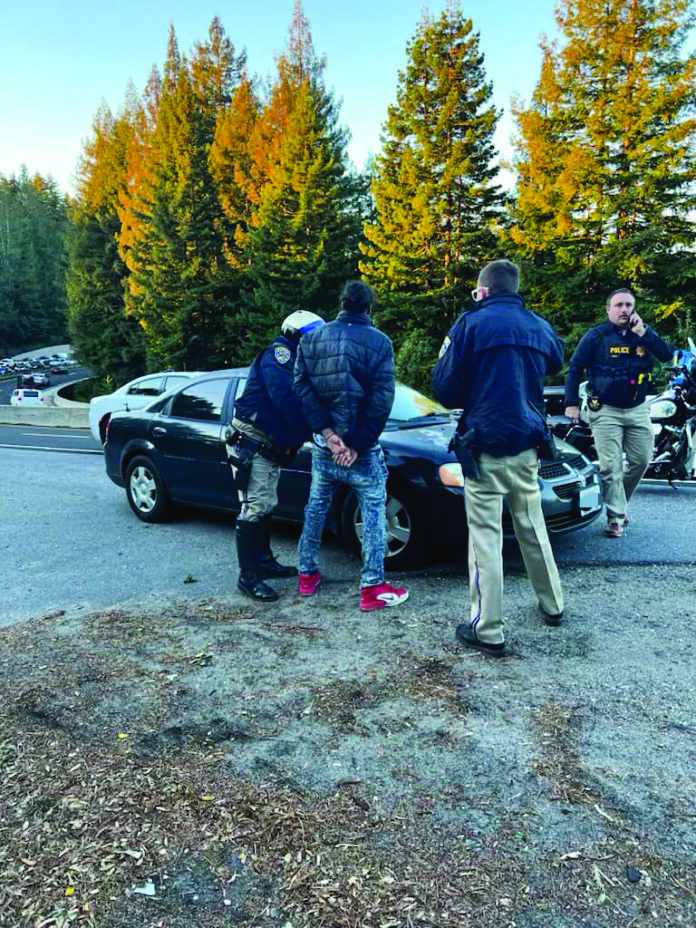Kristopher Payopay has failed to evade attempted murder charges. He’s accused of shooting at California Highway Patrol officers in Scotts Valley with a machine gun during a pursuit.
He was held to answer by Judge Hector Ramon for 10 crimes, plus enhancements, during a preliminary hearing in Santa Cruz County Superior Court on June 1.
“We’re looking forward to trying the case,” said Assistant District Attorney Conor McCormick. “We’re extremely thankful no one was injured.”
Dashcam footage in court showed CHP officers approaching an SUV along Highway 17 on Jan. 25 before it sped off and led them on a chase.
McCormick said it depicted Payopay aiming directly at officers with murderous intent.
The prosecution’s first witness was CHP officer Kordel Hoffman. He testified he and his partner spotted the black GMC Yukon on the side of the road and conducted a wellness check.
“I just wanted to make sure they were okay,” he said, adding he saw a man in the passenger seat and a woman in the driver’s seat, both slumped over.
He said they made frantic movements, and the woman hit the gas.
“I yelled at the driver to stop,” he said. “She continued to drive away.”
The video depicted the chase of the suspect vehicle, which wove between southbound lanes with its blinker, before exiting on Granite Creek Road.
A minute later, voices on the recording shouted, “Shots fired! Shots fired!”
Hoffman described the moment prosecutors say his life could have ended.
“I heard a clear and distinct shot,” he told the court. “I observed a flash from the passenger side.”
And despite hearing another gunshot, officers continued pursuing the vehicle, but at a slower pace, Hoffman testified.
Public defender Joe Ziebron tried to poke holes in the prosecution’s claim that Payopay was trying to hurt the highway patrollers.
He argued a muzzle flash doesn’t indicate the gun was pointed at officers.
Hoffman disagreed, adding he saw a bullet land right in front of their cruiser.
The second witness, Mario Galvez, a CHP investigator, testified three 7.62-millimeter bullet casings were found at the scene and turned out to be consistent with the AK-47 rifle later located—with its safety off—next to a house.
But no actual bullets were retrieved, he confirmed under questioning from Ziebron.
When he interviewed Payopay, Galvez said the suspect admitted to firing the gun. The witness turned his body to his right and pointed to the wall behind, recreating the movements he says the defendant made while confessing.
At first, Payopay tried to claim a third person did the shooting, but eventually, the suspect admitted to pulling the trigger, though he said he only fired into the air, Galvez said.
The investigator said he also interviewed Alexandria Luevanos, the driver. The latter pled no contest to a single-vehicle code violation and received a two-year State prison sentence (minus 112 days of credited time) on March 23.
“She thought she was going to go to prison if he shot the gun,” Galvez told the court, adding that Payopay gave her a heads-up before he used the firearm. “She described it as a Rambo-type gun.”
Galvez said that Luevanos thought Payopay had mortally wounded the CHP officers chasing them.
“She thought the cops were dead,” he said.
Investigators recovered a cellphone from the vehicle and uncovered an internet search for “Top 10 AK-47” weapons, text messages indicating Payopay bought one for $1,000, and photos of someone posing with just such a firearm.
Ziebron argued the way his client discharged the weapon wasn’t deliberate enough to constitute attempted murder.
The prosecution reminded the judge the bar for evidence is lower at a preliminary hearing than at trial.
“I believe the People have the better of the argument with respect to the ‘attempted murder,’” Judge Ramon said, referring to counts 1 and 2.
Payopay is due back in court on June 16 and remains in custody. He faces up to life in prison.













